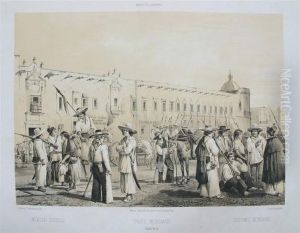Casimiro Castro Paintings
Casimiro Castro was a Mexican lithographer and painter, born in the year 1826 in Mexico City. He is best known for his detailed lithographs that depict various aspects of 19th-century Mexican life, including its landscapes, urban scenes, and daily activities. Castro's work serves as a significant visual record of Mexico during a period of great change and modernization.
During his career, Castro collaborated with other artists and printers to produce 'Album del Ferrocarril Mexicano' (Mexican Railway Album) in 1855, which was a collection of lithographs celebrating the inauguration of the first Mexican railway line between Mexico City and the nearby town of Guadalupe Hidalgo. However, his most famous work is arguably 'México y sus alrededores' (Mexico and its Surroundings), published in various editions from the 1850s to the 1870s. This collection of views is an invaluable resource for understanding the country's history, offering insights into its urban development and social customs.
Castro's style was characterized by attention to detail, and his ability to capture the essence of the subjects he portrayed. His work not only holds artistic value but is also of great historical importance, providing a window into the Mexican society of his time. He was an astute observer of his surroundings, and his lithographs often include a wide array of subjects from different social strata, thus offering a comprehensive picture of the diversity of Mexican life.
Despite the prominence of his work during his lifetime, Casimiro Castro remains a lesser-known figure in the broader scope of art history. Nevertheless, his contributions have been recognized in Mexico, and his lithographs are often studied for their historical and cultural significance. Castro's work has been featured in various exhibitions, and his original prints are sought after by collectors interested in Mexican history and art.
Casimiro Castro died in 1889, leaving behind a rich legacy of visual documentation of Mexican life in the 19th century. His work continues to be appreciated for its artistic qualities and its value as a historical record of a dynamic period in Mexico's past.
